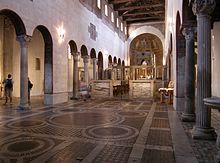Schola cantorum (architecture)

The Schola cantorum is an enclosed area in medieval churches in Rome . It is located in the nave of the church and was the place for clerics and the singing choir during the service. The term “schola cantorum” came about later and is found for the first time in the 16th century in a description of the Church of San Clemente in Rome by Pompeo Ugonio .
After initially inconsistent design, the uniform type of enclosed rectangular area to the west of the choir , about one meter from the choir barriers , developed from the 9th century to the 11th century . It was bordered by marble barriers and had entrances to the east and west. In the middle of the long sides were the raised ambo and the pulpit . The enclosure was often adorned with Kosmaten decorations. Such scholae were built in Rome and Latium until the 16th century, when churches were rebuilt in the Baroque period they were mostly removed. From then on, the place for the singers was the choir gallery , mostly at the end of the main nave opposite the altar.
Scholae cantorum are known from the following churches in Rome:
- San Giovanni in Laterano
- San Clemente (lower church and upper church, there partly reused and preserved)
- Santa Maria in Aracoeli
- Santa Sabina
- San Pietro in Vincoli (preserved)
- Santa Maria Antiqua
- Santa Maria in Trastevere
Comparable to the Schola cantorum , the Bema in early Byzantine churches in Syria is the ritual center during the divine service .
Individual evidence
- ^ Matthias Hamann : Schola cantorum. I. Architecture . In: Walter Kasper (Ed.): Lexicon for Theology and Church . 3. Edition. tape 9 . Herder, Freiburg im Breisgau 2000, Sp. 197 f .
- ^ Rainer Warland : Bema . In: Walter Kasper (Ed.): Lexicon for Theology and Church . 3. Edition. tape 2 . Herder, Freiburg im Breisgau 1994, Sp. 195 .
